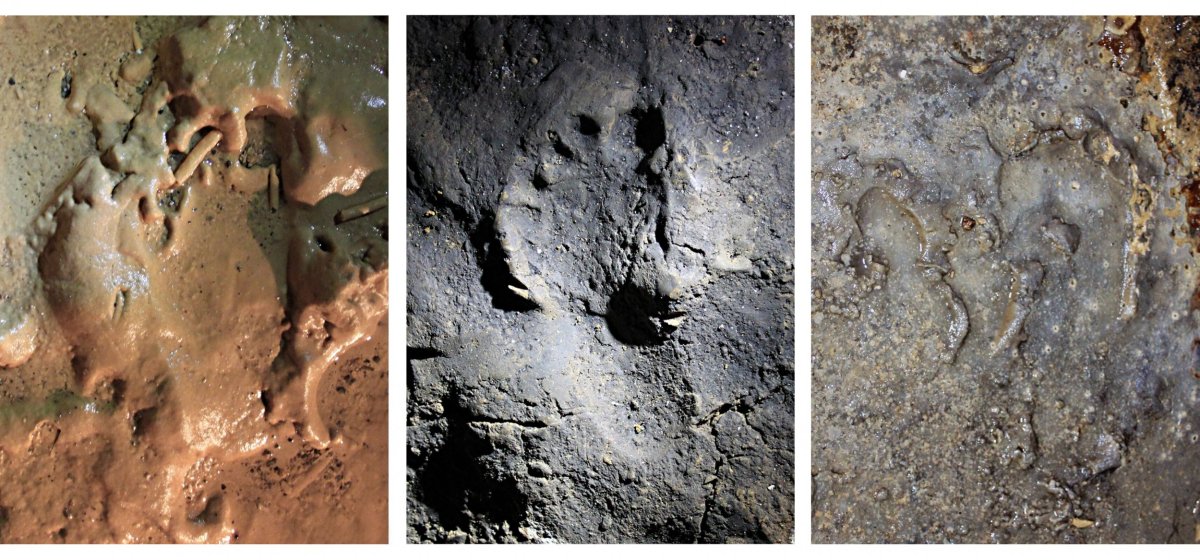The perfectly preserved footprints of Stone Age humans who lived 14,000 years ago discovered deep in a cave in Italy are helping scientists understand how these paleolithic people explored new systems—by crawling through the low tunnels—as a group activity.
Ancient humans—and our ancestors and extinct relatives—have used caves for shelter throughout history. In the Panga ya Saidi cave in Kenya, there is evidence to suggest humans occupied this system for 78,000 years.
A team of scientists, lead by Marco Romano from the University of the Witwatersrand in South Africa, has now analyzed human activity at the cave of Bàsura at Toirano. Scientists first discovered ancient human and animal activity at the site in the 1950s, and it has been explored by archaeologists ever since.
However, just how early humans navigated their way around the cave, which extends 890 meters into a mountain, was unclear.
In a study published in the journal eLife, Romano and colleagues provide evidence to show that Stone Age people living in the region around 14,000 years ago would crawl around the cave system, that the cave was used for social reasons as well as to find food, and that this was a group activity—with even the youngest members exploring the cave.

The team analyzed 180 tracks that had been imprinted into cave's clay floor. These included human foot and handprints. From this, they were able to reconstruct the way people were moving around the system.
"The preservation of many footprints is truly exceptional, preserving even the smallest details of the feet and other portions of the limbs that have impressed them. In the case of some knee prints, we were able to recognize using 3D models incredible anatomical details of the leg," Romano told Newsweek.
He said they wanted to find out how ancient humans were exploring the cave system—how they entered, what route they took once inside, and if this was a group or individual activity.
Researchers found five individuals were using the cave at one time. These were two adults, an adolescent and two children aged around three and six years. This group would have entered the cave barefooted and barelegged and would crawl through the low tunnels in order to access the inner part of the cave. They illuminated the cave using bunches of wooden sticks, the researchers say. Romano said they believe the cave was only explored once by this single group.
"In fact the substrate has remained soft for hundreds of years, and people who have subsequently entered would have imprinted new prints on it," he said. "In addition, the entrance to the cave was closed by a stalactite that is the same age as the studied prints. So from that moment no humans could enter the cave, until the 1950s when stalactite was blown up with dynamite for the first modern exploration."
The handprints indicate the group was using the cave for a variety of purposes—including for exploration only. "Intentional" handprints suggest the inner chambers of the cave were used for social and/or symbolic activities. "Hunter-gatherers may therefore have been driven by fun activities during exploration, as well as simply the need to find food," Romano said in a statement.

Further to this, the team also discovered 111 dog-like tracks that were closely associated with the human prints—potentially meaning humans were accompanied on cave exploration trips by dogs. This, the researchers say, warrants further investigation as it could provide an insight into dog domestication in during the upper paleolithic.
Romano says there are many hand and footprints made by anicent humans in other caves. However, this is the first time scientists have been able to show that humans would crawl and walk on all fours around these systems. The team will continue to work at Bàsura at Toirano in order to better understand its inhabitants.
"Current and subsequent studies will focus on the preserved animals traces, and their relationship with human footprints," he said. "In addition, we will focus on more archaeological aspects and on the art produced by the explorers in the inner rooms of the cave."
Uncommon Knowledge
Newsweek is committed to challenging conventional wisdom and finding connections in the search for common ground.
Newsweek is committed to challenging conventional wisdom and finding connections in the search for common ground.
About the writer
Hannah Osborne is Nesweek's Science Editor, based in London, UK. Hannah joined Newsweek in 2017 from IBTimes UK. She is ... Read more
To read how Newsweek uses AI as a newsroom tool, Click here.








